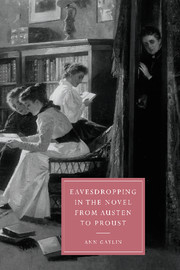Book contents
- Frontmatter
- Contents
- Acknowledgments
- Introduction
- 1 I'm all ears: Pride and Prejudice, or the story behind the story
- 2 Eavesdropping and the gentle art of Persuasion
- 3 Household words: Balzac's and Dickens's domestic spaces
- 4 The madwoman outside the attic: eavesdropping and narrative agency in The Woman in White
- 5 La double entente: eavesdropping and identity in A la recherche du temps perdu
- Conclusion: covert listeners and secret agents
- Notes
- Select bibliography
- Index
2 - Eavesdropping and the gentle art of Persuasion
Published online by Cambridge University Press: 22 September 2009
- Frontmatter
- Contents
- Acknowledgments
- Introduction
- 1 I'm all ears: Pride and Prejudice, or the story behind the story
- 2 Eavesdropping and the gentle art of Persuasion
- 3 Household words: Balzac's and Dickens's domestic spaces
- 4 The madwoman outside the attic: eavesdropping and narrative agency in The Woman in White
- 5 La double entente: eavesdropping and identity in A la recherche du temps perdu
- Conclusion: covert listeners and secret agents
- Notes
- Select bibliography
- Index
Summary
Your tale, sir, would cure deafness.
Shakespeare, The TempestIn ages of imagination this firm persuasion removed mountains; but many are not capable of a firm persuasion of anything.
Blake, The Marriage of Heaven and HellA novel that Austen herself criticized as being “too light, and bright, and sparkling,” Pride and Prejudice ends optimistically, with its principal characters wed on linguistic and narrative levels. In a text whose last two words are “uniting them” (396), Elizabeth and Darcy have overcome the obstacles to a happy marriage and thus, in Austen's imagined world, to happy lives. Instead of a “truth universally acknowledged,” Elizabeth and Darcy have learned the truth about each other and themselves. Rather than listening to proliferating stories, they finally get the story “right,” by listening to each other. The conclusion implies that their subsequent tale, in its almost perfect completeness, need not be told. Narrative plenitude replaces narrative lack; in Barthes's words, narrative (dis)closure replaces narrative “‘reticence,’ the rhetorical figure which interrupts the sentence, suspends it, turns it aside.”
Austen's final novel presents a much less ebullient ending, and, in its more complex and pervasive use of eavesdropping, offers a more qualified sense of individuals' ability to communicate, and the possibilities for complete disclosure. Rather than attempting to relate the “true” story, Persuasion (1818) explores the subjective nature of storytelling. Individuals leave the imprint of their imagination on the stories they tell.
- Type
- Chapter
- Information
- Eavesdropping in the Novel from Austen to Proust , pp. 42 - 57Publisher: Cambridge University PressPrint publication year: 2003

